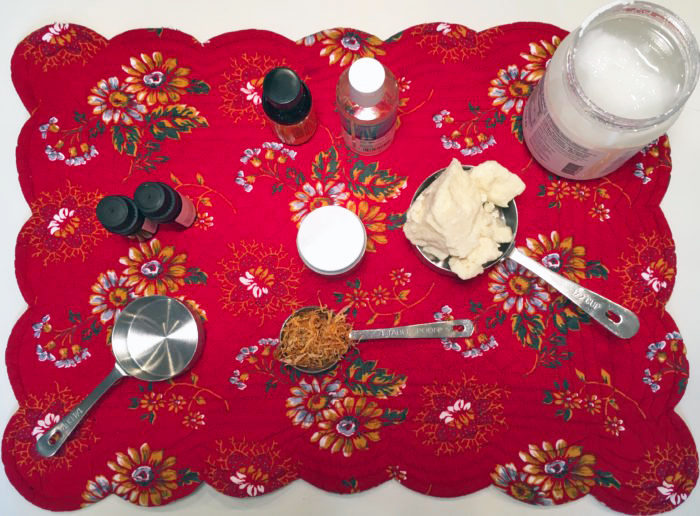Beeswax is such a common ingredient in organic skincare and cosmetic products that vegans can often feel left out. But, fret not! Being bee-free doesn’t mean having to go without lip balms, body lotions, and hair care products. The idyllic bee-free alternative comes from the candelilla plant, a flowering bush native to the Chihuahuan Desert in Mexico. Each stalk of candelilla naturally produces a wax coating during the rainy season, which can be harvested and turned into a substitute for beeswax. Once refined into pastilles, candelilla wax can be used to make many beauty products-including your own DIY vegan healing balm for bumps, bruises, and sprains. This balm makes the perfect addition to your summer first aid kit!
Ingredients
–8 oz. shea butter (raw, organic)
–25 oz. coconut oil
–3 tablespoons dried Calendula (Calendula officinalis) petals, tightly packed
–3 tablespoons dried Arnica (Arnica Montana), tightly packed
–4 tablespoon candelilla
–1/4 teaspoon Vitamin E essential oil
–15 drops lavender essential oil
–15 drops tea tree essential oil

Directions
1. To begin, heat your oven to 200 degrees F°. When the temperature reaches 200 degrees, turn it off.
2. While the oven is heating up, melt 15 oz of coconut oil and the 8 oz shea butter in a pan on your stove. Then add the calendula and arnica herbs and move the pan into the oven
3. Let this concoction steep there for 4-5 hours.
4. Strain the calendula and arnica from mixture; then add in some more coconut oil (about 10 oz.).
5. Next, heat the stove top and put the oil mixture into the hot pan. Now, add the candelilla wax and stir the mixture until it’s melted.
6. Turn down the heat of the stove and stir the vitamin E, tea tree, and lavender essential oils into the wax mixture.
7. Keep the jar in a tepid place and use the balm for painful bumps and bruises.
Please note: These amounts are experimental and may vary depending on how much balm you want to make!
Healing Information
Calendula (Calendula officinalis): Also known as Marigold, this plant is known for its anti-inflammatory and healing properties. Calendula has high amounts of flavonoids, which are plant-based antioxidants that protect cell damage by free radicals. Calendula expedites wound healing, believed to occur by increasing blood flow and oxygen to an affected area—this helps the body grow new tissue. Other benefits? Skin firming and hydration!
Arnica (Arnica Montana): A homeopath’s herb of choice, Arnica contains sesquiterpene lactones, which reduce inflammation and decrease pain. This mechanism occurs by dispersing fluids that build up in bruised and injured tissue. Arnica is native to high mountains of western North America.
Lavender: One of the most widely-used essential oils, lavender has powerful antiseptic properties. Applying it to wounds can not only increases cell growth, causing the wound to heal faster, but also decreases the appearance of scars. Lavender’s anti-microbial action protects scrapes and wounds from infection while allowing them heal.
Tea Tree: Tea tree oil contains antiseptic and antibacterial properties that can treat insect bites, acne, head lice, and eczema. Tea tree oil is concentrated plant oil from the leaves of the Melaleuca alternifolia tree, which is native to Australia. First discovered by Australian Aborigines, its wisdom as a healing agent has been recognized for thousands of years.
Have you tried making a DIY vegan healing balm?
Also by Leigh: Restorative Yoga Retreat: How to Practice Legs Up the Wall
How to Create Your Own Aromatherapy Mood Blends
Related: DIY Luxurious Whipped Body Butter
Get more like this—Subscribe to our daily inspirational newsletter for exclusive content!
__
Photo: Leigh Winters




